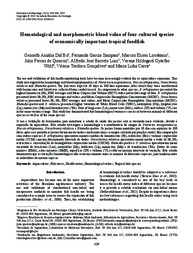Hematological and morphometric blood value of four cultured species of economically important tropical foodfish.
Hematological and morphometric blood value of four cultured species of economically important tropical foodfish.
Author(s): DAL'BÓ, G. A.; SAMPAIO, F. G.; LOSEKANN, M. E.; QUEIROZ, J. F. de; LUIZ, A. J. B.; WOLF, V. H. G.; GONÇALVES, V. T.; CARRA, M. L.
Summary: Abstract: The use and validation of fish health monitoring tools have become increasingly evident due to aquaculture expansion. This study investigated the hematology and blood morphometrics of Piaractus mesopotamicus, Brycon orbignyanus, Oreochromis niloticus and Rhamdia quelen. The fish were kept for 30 days in 300-liter aquariums, after which they were anesthetized with benzocaine and blood was collected from caudal vessels. In comparison to other species, B. orbignyanus presented the highest hematocrit (Ht), RBC averages and Mean Corpuscular Volume (MCV) with a particular range of data. B. orbignyanus presented lower Ht, Hb, RBC averages and values, and Mean Corpuscular Hemoglobin Concentration (MCHC). Oreochromis niloticus presented lower Ht, Hb, RBC averages and values, and Mean Corpuscular Hemoglobin Concentration (MCHC). Rhamdia quelen and O. niloticus presented higher variation of White Blood Cells (WBC), neutrophils (Nf), lymphocytes (Lf), monocytes (Mf) and thrombocytes (Trb). Data of large axes (LA), minor axes (MA), surface (SF) and volume (VL) are in the same variance range. This study has demonstrated that hematological variances can occur between animals of different species as well as of the same species. Resumo: O uso e validação de ferramentas para monitorar o estado de saúde dos peixes está se tornando mais evidente, devido à expansão da aquicultura. Este estudo investigou a hematologia e a morfometria do sangue de Piaractus mesopotamicus, Brycon orbignyanus, Oreochromis niloticus e Rhamdia quelen. Os peixes foram mantidos por 30 dias em aquários de 300 litros, após esse período os peixes foram anestesiados com benzocaína e o sangue coletado por punção caudal. Em comparação com outras espécies B. orbignyanus apresentou maiores médias de hematócrito (Ht), eritrócitos (Eri) e volume corpuscular médio (VCM) com um determinado intervalo de dados. Oreochromis niloticus apresentou menor média e valor de Ht, Hb, eritrócitos e concentração de hemoglobina corpuscular média (CHCM). Rhamdia quelen e O. niloticus apresentaram maior variedade de leucócitos (Leu), neutrófilos (Nf), linfócitos (Lf), monócitos (Mf) e de trombócitos (Trb). Dados de eixos maiores (EMA), eixos menores (EME), superfície (SF) e volume (VL) estão no mesmo intervalo de variação. Este estudo demonstrou que as variações hematológicas não ocorrem somente entre os animais de diferentes espécies, mas também entre os indivíduos da mesma espécie.
Publication year: 2015
Types of publication: Journal article
Unit: Embrapa Environment
Observation
Some of Embrapa's publications are published as ePub files. To read them, use or download one of the following free software options to your computer or mobile device. Android: Google Play Books; IOS: iBooks; Windows and Linux: Calibre.
Access other publications
Access the Agricultural Research Database (BDPA) to consult Embrapa's full library collection and records.
Visit Embrapa Bookstore to purchase books and other publications sold by Embrapa.

